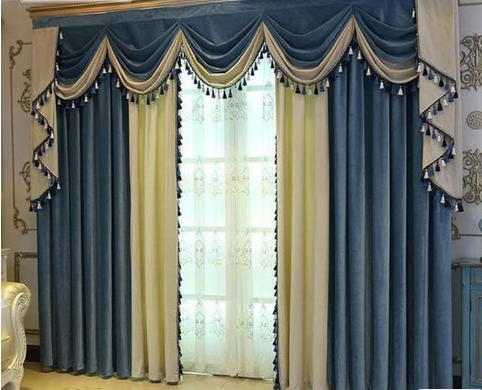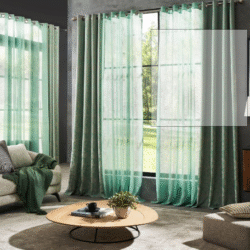Curtains are more than just functional items that provide privacy and block out light—they are essential design elements that can transform the look and feel of a room. Whether you’re decorating a cozy living room or creating a stylish bedroom retreat, the right curtain choice can enhance your interior decor, adding color, texture, and personality. In this article, we’ll explore the various aspects of curtain decor, from selecting the perfect fabric to finding the ideal length and style that suits your space. Whether you prefer minimalist elegance, bold patterns, or luxurious textures, curtains offer endless possibilities to elevate any room’s aesthetic. Let’s dive into how you can use curtains to create a beautiful and inviting atmosphere in your home.
Choosing the Right Fabric for Your Curtains
When choosing the right fabric for your curtains, there are several key points to consider:
- Functionality: Think about what you need your curtains to do. If you want to block out light, opt for heavier fabrics like velvet or blackout materials. For a softer, light-filtering effect, go for linen or cotton blends.
- Room Type: Different rooms require different fabrics. In living rooms and bedrooms, luxurious fabrics like silk or velvet can add a touch of elegance, while in kitchens or bathrooms, durable, moisture-resistant materials like polyester or cotton are better suited.
- Color and Pattern: Choose a fabric color and pattern that complements your existing decor. Lighter colors and simple patterns can make a room feel larger and airier, while darker colors and bold patterns add drama and sophistication.
- Maintenance: Consider how much effort you’re willing to put into maintaining your curtains. Natural fabrics like linen or cotton may need more frequent washing, while synthetic materials like polyester are easier to care for and more durable.
- Texture: The texture of the fabric can significantly affect the look and feel of a room. A smooth, sleek fabric like silk creates a refined atmosphere, while textured fabrics like tweed or linen offer a more casual, relaxed vibe.
- Climate Considerations: The climate in your area can influence fabric choice. Lighter fabrics are ideal for warmer climates as they allow air circulation, while heavier fabrics are better for colder regions, offering insulation and warmth.
- Durability: If your curtains are in a high-traffic area, choose a fabric that can withstand wear and tear, such as polyester, which is durable and resistant to fading.
Color Trends in curtain decor Design
Color plays a crucial role in curtain design, setting the tone of a room and complementing your overall decor. Here are some current color trends in curtain design:
- Soft Neutrals: Shades like beige, taupe, and light gray continue to dominate. These versatile colors create a calm and serene atmosphere, making them perfect for bedrooms and living rooms. They pair well with almost any color scheme and can complement a range of interior styles, from modern to traditional.
- Earthy Tones: Rich, earthy hues like terracotta, olive green, and mustard yellow are gaining popularity. These colors evoke warmth and nature, making them ideal for creating cozy and inviting spaces. Earthy tones also add a touch of sophistication while keeping things grounded and organic.
- Bold Jewel Tones: Vibrant, deep jewel tones such as emerald green, sapphire blue, and amethyst purple are making a statement in modern homes. These colors add drama and luxury to any room, often used in high-ceiling spaces or rooms meant for entertaining, such as dining rooms or living areas.
- Pastels: Soft pastels, such as blush pink, lavender, and light blue, are trending for creating light, airy spaces with a touch of elegance. Pastels work well in bedrooms, nurseries, or any space where you want a calm, relaxed vibe.
- Monochromatic Schemes: Opting for curtains in shades that match the walls or furniture creates a harmonious, monochromatic look. This trend is popular in minimalist interiors where subtlety and cohesion are key.
- Deep Blues and Navy: Navy blue has become a timeless and stylish option for curtains, bringing a sense of sophistication without feeling too heavy. It pairs well with both warm and cool-toned furnishings, making it a flexible choice for many interior styles.
- Metallic Accents: Metallic tones like gold, silver, and bronze are being used in curtain designs to add a touch of glamour. These metallic fabrics often have a sheen or shimmer, reflecting light and making the room feel more luxurious and vibrant.
- Black and Charcoal: While darker colors like black and charcoal were once avoided in curtain design, they are now being embraced for their ability to create bold, dramatic looks. These colors are ideal for modern or industrial-style homes and can help make other colors in the room pop.
- Patterned Curtains with Color: Colorful patterns, such as geometric prints, floral designs, and abstract patterns, are gaining traction. These patterns inject personality and movement into a space, especially when paired with neutral walls and furniture.
How to Match Curtains with Interior Themes
Matching curtains with your interior theme is essential for creating a cohesive and balanced look. Here are some tips on how to seamlessly blend your curtains with your room’s decor:
Match with the Color Palette:
For a harmonious look, choose curtain colors that complement the room’s existing color scheme. If your interior features neutral tones, you can opt for curtains in shades like beige, gray, or white for a subtle, understated effect. Alternatively, if the room is colorful, select a neutral curtain that won’t compete with bold furniture or decor. If you want the curtains to be a focal point, choose a contrasting or vibrant color that adds a pop of interest without overwhelming the room.
Consider the Room’s Function:
For spaces like bedrooms or home offices, where relaxation or focus is key, opt for soft, muted tones and fabrics that promote a calm atmosphere. Fabrics like cotton, linen, or velvet in pastel or neutral shades work well. In living rooms or entertainment spaces, you may choose bolder patterns or rich textures to add drama and personality.
Complement the Style of Furniture:
- Modern/Minimalist: Choose clean, simple curtains in neutral colors, often in fabrics like linen or cotton. Avoid heavy patterns and focus on sleek finishes like metal curtain rods or simple tiebacks.
- Traditional: Rich fabrics like velvet, silk, or brocade in deep hues (such as burgundy, navy, or forest green) can complement traditional furnishings. Patterned or textured curtains, such as floral prints or damask patterns, fit well with more classic interior themes.
- Bohemian: For eclectic and bohemian-inspired spaces, consider using patterned curtains with vibrant colors, floral motifs, or ethnic prints. Sheer or lightweight fabrics like linen or cotton add an airy, relaxed vibe.
Texture and Fabric Selection:
The texture of your curtains should reflect the atmosphere you wish to create. Heavier fabrics like velvet or brocade lend sophistication to formal spaces, while lighter fabrics such as linen or cotton work better in casual or coastal-style interiors. For a more contemporary or industrial theme, you could use fabrics like denim, tweed, or even metallic textiles to complement your furniture.
Coordinate with Flooring and Walls:
- Matching Curtains with Walls: If your walls are a focal point with bold colors or intricate wallpaper, opt for curtains in a simple, complementary tone to avoid overwhelming the space.
- Matching Curtains with Flooring: Curtains that match the tone of your flooring (whether wood, tile, or carpet) can create a seamless, unified look. Wooden blinds or bamboo curtains pair beautifully with hardwood floors, while soft fabrics like linen can balance out marble or stone floors.
- Length and Style: The length and design of your curtains should fit the overall theme of the room. For a minimalist or contemporary look, go for floor-to-ceiling curtains with a sleek, modern design.
- For a more classic or vintage theme, draped or puddled curtains that pool slightly on the floor can create a more luxurious, traditional feel.
- Use of Patterns: If your room has minimal furniture or is dominated by solid colors, curtains with bold patterns (like stripes, florals, or geometric prints) can introduce visual interest. Conversely, if your room already has many patterns, go for solid-colored curtains to avoid clashing.
- Matching Patterns: For more coordinated interiors, match the curtain pattern with accents in the room, like cushions, throws, or rugs, for a unified design.
- Experiment with Layers: Layering curtains with sheers and heavier drapes is a great way to adapt your curtains to different themes. Sheer curtains create an elegant, airy look, suitable for a coastal or minimalist room, while heavier drapes add warmth and sophistication to a traditional or classic space.
By carefully considering your interior theme, furniture style, and color palette, you can select curtains that enhance and complete the overall aesthetic of your room.
Curtain Styles: From Classic to Contemporary
Curtain styles have evolved significantly over time, offering a wide range of options to suit every taste and interior design theme. Classic curtain styles remain popular for their timeless elegance and refined appeal. These include pleated drapes, valances, and swags, often made from rich fabrics like velvet, silk, or brocade. They typically feature ornate details, tassels, and decorative tiebacks, making them ideal for traditional or formal spaces such as dining rooms or master bedrooms.
On the other hand, contemporary curtain styles embrace simplicity, clean lines, and functionality. Grommet and eyelet curtains, for example, offer a sleek, modern look and are easy to slide open and closed. They are often made from light fabrics such as cotton or linen and are perfect for minimalist or Scandinavian-inspired interiors. Another modern option is the use of sheer curtains, which filter natural light beautifully while maintaining privacy, creating an airy and open feel.
For those who enjoy blending styles, transitional curtain designs mix elements of both classic and modern aesthetics, offering versatility and balance. Patterns, colors, and materials play a significant role in defining a curtain’s style, allowing homeowners to express their personal taste. Whether you prefer the grandeur of traditional drapery or the fresh appeal of modern designs, the right curtain style can truly elevate any room’s atmosphere.
Read also:
conclusion
In conclusion, curtain décor is a vital element in shaping the character and comfort of any room. From choosing the right fabric and color to selecting a style that complements your interior theme, every detail plays a role in enhancing the overall aesthetic and functionality of your space. Whether you prefer classic elegance, modern minimalism, or a unique blend of both, curtains offer endless possibilities to reflect your personal style and elevate your home décor. With thoughtful selection and creative design, the perfect curtains can transform an ordinary room into a warm, inviting, and stylish retreat.




